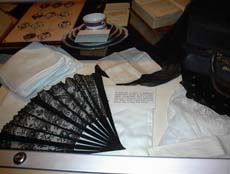|
“With
a new museum we could become an integral part of the ‘Looking
for Lincoln’ tourism project.
It would enhance tourism if we could properly display all
the Lincoln artifacts that we have,” he said.
“Looking
for Lincoln” is being developed to tell the Abraham Lincoln
story in the places where it happened, which include Logan County
and other communities in Central Illinois.
The Lincoln Presidential Library to be built in Springfield
will become a jumping-off point for tourists to visit other sites
in the area to learn about our 16th president’s life and times.
Nutt
sees the city of Lincoln becoming part of the influx of tourism
that is expected to result from the “Looking for Lincoln”
project. “Lincoln
is always our number-one president, and tourism in Central
Illinois is going to burgeon,” he said.

[The museum has items belonging to Mary Todd
Lincoln, including a fan which was part of her
mourning clothing,
gloves, a small valise
and monogrammed napkins.]
“Wherever
they have the ‘Looking for Lincoln Trail,’ we’re going to
have Lincoln College Museum brochures,” he added.
He would like the museum to have an introductory film and
perhaps a docent to serve as a guide to visitors.
His
vision of a completed campus includes a field house that would
hold 1,200 people for athletic events, with the possibility of
seating another 1,000 in chairs on the floor. “We have nothing
on campus now that will hold our entire student body,” he
pointed out.
The
new museum would provide 3,000 square feet of display space, more
than three times the space in the present museum in a wing of
McKinstry Library. The
new field house, he noted, would also provide ample parking for
museum visitors, which is not available at its present location.
The
museum today is not large enough to hold all the Lincoln material
the college now owns, and Nutt believes other materials might be
donated if the college had the proper space to exhibit them.
“If
we could display things properly, I think there are people out
there who would give us items that would double the value of our
museum,” he said.
The
college is also in the process of searching for an employee who
could serve as curator of the museum as well as holding a teaching
position.

[The desk and chair
used by Abraham Lincoln when he served in the Illinois House of
Representatives is displayed in the Lincoln College Museum, with a
photo of the Old State Capitol chambers in the background.]
The
Lincoln College Museum began with the collection of Judge Lawrence
B. Stringer, an 1887 Lincoln University graduate.
(Lincoln College was originally chartered as Lincoln
University.) The
judge died in 1942 and left his sizable Lincoln and Logan County
history collection to the college, with the provision that a
museum be built to house it.
Other acquisitions have since been added.
|
Among
the important items in the museum are the original Lincoln town
charter drawn up by Abraham Lincoln, Logan County’s first two
land grants, the desk Lincoln used in the Illinois legislature,
china and clothing belonging to Mary Lincoln and many documents
with Lincoln’s signature.
“We
try to center our collection around things that happened prior to
Lincoln’s election as President,” Nutt said.
As
part of the field house-museum complex, he would like to add a
Logan County Hall of Fame in which both athletic and non-athletic
achievers would be recognized.
Athletes such as Tony Semple of the Detroit Lions and
basketball stars Chuck Verderber, who played for the University of
Kentucky, and Brian Cook, who recently won a basketball
scholarship to the University of Illinois, would be included, as
well as writers William Maxwell and Langston Hughes and the late
Ed Madigan, a former state representative who also served in the
U.S. Congress and as secretary of agriculture under President
George Bush.
Nutt
said he would start a fund-raising campaign next fall “to tell
us whether we have the money to build a new field house.”
He is optimistic about raising the $3 million he believes
the field house will cost, but says the college will be looking
for state or federal funding to help defray the estimated $2
million cost of the new museum.
He said if funds permit he would also like to construct
three indoor tennis courts.

[Dr. Jack Nutt, Lincoln College president since
1982, stands beside a painting of University Hall, the original
college building, as he discusses plans
for the college’s future.]
Funding
for the current building program, which will add a new dormitory,
a new classroom and office building, and an addition to the
Johnston Center for the Performing Arts, is already in place,
according to Nutt. He
noted that the college has had good cooperation from the local
banks, both in Lincoln and in Normal, where the college has a
second campus, and that its bonds are well rated.
When
he came to the college in 1982, there were fewer than 300
students, both here and at the Normal campus, he said.
Now there are 1,045 on both campuses, including residential
and commuter students. The
two campuses have a full-time equivalent of 850 students, with 650
of them at Lincoln, and the college already has 150 more
applications than it has seats for next fall semester.
President
Nutt sees a total of 525 residential students as ideal for the
college’s mission, which is the personal approach to education,
giving the student the individual attention that might make the
difference between success and failure.
The current building program and the proposed field
house-museum complex will complete his plan for the 50-acre
college campus.
“I’d
love to have our whole campus finished by the time the Lincoln
Presidential Library is completed, probably in 2004 or 2005,” he
said.
[Joan
Crabb] |



